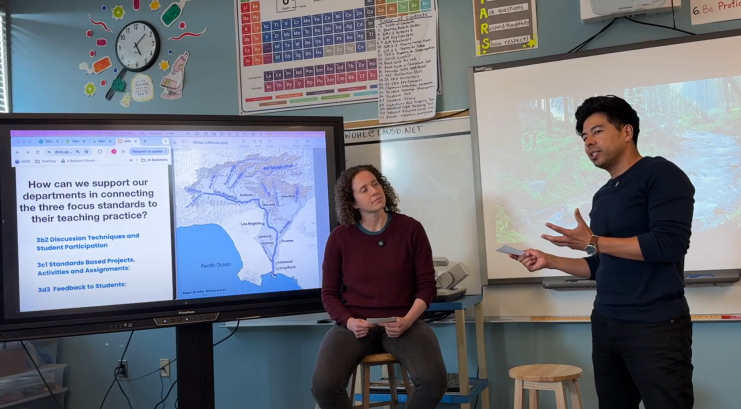
From Rivers to Watersheds: An Inquiry into Cross-Department Collaboration
“What if we formally planned and started hosting our Science and History department meetings together?”
As chairs of two separate departments – History and Science – we initially viewed our leadership roles as two parallel rivers, sharing certain features and at times crossing paths, but ultimately separate. For our first year and a half of serving together on Luther Burbank Middle School’s Instructional Leadership Team, (ILT), we primarily worked together as planning partners – creating similar agendas for our meetings, checking in about our department members who teach both History and Science, and observing each others’ classrooms to refine our shared practices, such as Socratic Seminars. However, it wasn’t until this year that we decided to meet together in the same room during our professional development time. With the support of a willing and trusting administration behind us, we merged our rivers into one.
How did this decision come about?
Over the course of the first semester, we began to realize that the focus of the work in our department meetings had shifted from more content-specific, technical planning towards what we now know as “adaptive expertise.” Adaptive expertise describes the ability to apply professional knowledge in new ways, analyze personal beliefs and limitations related to professional practices, and seek expert knowledge when problems arise (Street Data, Safir & Dugan, Corwin 2021). Through our work with Lead by Learning, we realized that as our professional development goals shifted towards these types of capacity-building skills, we could do the majority of our work together and then break off into smaller meetings when we needed to focus on more technical planning.
Once we decided to merge our meetings, we began to see momentum building toward our inquiry question – how can we support our departments in connecting the three whole-school focus standards to their teaching practice? – but also new connections forming within and across our departments that we could not have anticipated.
We started by creating a rotating agenda of practices to cycle through.
- Check-in and Team Building Activity: if we are going to ask people to be vulnerable, we have to build trust and comfort around each other first.
- Resource Sharing Connected to our Three Whole-School Focus Standards: These resources included articles and videos on the discussion techniques, standards-based projects, and on giving feedback to students.
- Public Learning: The bedrock of what we’ve been doing for the last couple of years with support from Lead by Learning.
- Sharing Best Practices: We encouraged our department members to consider sharing about a dilemma or skill related to a focus element; however, the connection was optional.
While we had initially hoped to cycle through all of these practices within a single professional development meeting, we soon realized that this was over-ambitious given the time constraints. We shifted towards beginning our meetings with the check-in or teambuilding and then following with just one of the other practices listed. Thus, over a period of three professional development meetings, we would engage in all of the practices.
The Impact
While we had anticipated influencing teacher learning modestly, the impacts were more far-reaching than we could have hoped for. On multiple occasions, we observed that somewhat organically, a miniature inquiry cycle would build and play out between teacher dyads as we rotated through the three more substantive practices on our agenda – resources, public learning, and best practices. For example, one of our 8th-grade science teachers was working with an 8th-grade history teacher in their Public Learning. In the next rotation, when the Science teacher had to talk about a best practice, his best practice actually stemmed directly from the conversation that he had with the history teacher in Public Learning. He attributed the resource he shared directly back to that conversation, and he had actually co-created the resource with the History teacher, who was also planning to use it in his own classroom. This told us that the work our adult learners did through Public Learning impacted their teaching – and this was just one single example out of many. Their collaborative conversations informed their practices.
What are we thinking now?
Upon reflecting on the year, we came to see our work as not just two rivers but as a watershed. A watershed is an area of land that drains all the streams and rainfall to a common outlet such as the outflow of a reservoir, mouth of a bay, or any point along a stream channel. The repeated structure of our meetings with built-in practices gave us the landscape that all of our work began to flow through. Without even really knowing how the pieces were going to fit together, the implementation of our repeated practices started to funnel our departments’ work toward one stream channel with a clear direction. When we looked back at our three focus elements, we realized that these fit into our metaphor as well. The whole-school elements were the source of the water, much like snow on a mountain, that we could look towards and draw from. But, it was through the topography that we set up that these guiding elements could flow in a unique way that was relevant to our departments.
As we looked at our end-of-year department reflection data, we saw that Public Learning and sharing of best practices were rated the most helpful in terms of actually leading to student impact. Additionally, compared to the beginning of the year, our colleagues’ sentiment of working together as a combined department grew to 77% of colleagues wishing to continue to work and meet together.
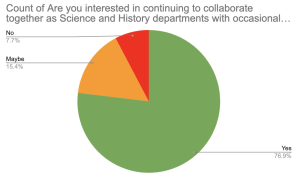
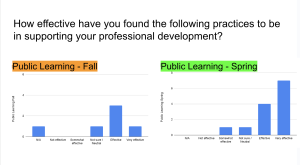
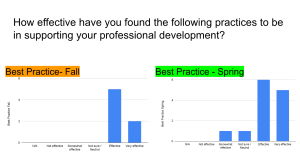
We hope that this story is helpful to other leaders and learners who are looking to build cross-departmental collaboration. While we recognize that our school’s unique block schedule and programming lend themselves to such close collaboration between Science and History departments in a way that may not be possible at all schools, we do believe that elements of our work may be useful to other schools, especially those looking to build collaboration and momentum in smaller departments.
As we move into next year, we are hoping to deepen the effectiveness of our rotating agenda by weaving in two additional practices – teacher walkthroughs and the sharing of student work. While we have encouraged both of these practices in informal ways in the past, we hope that formalizing the process will allow us to better understand our impact on students across different classrooms and grade levels and will inform our individual and department goals moving forward. While we know that adding a data collection cycle into our work will demand a higher level of vulnerability from our department members, we believe the foundation we have already built will enable us to continue building momentum toward these goals.
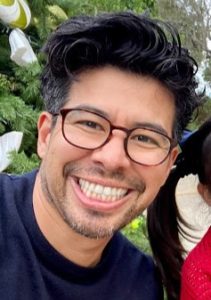
Gustavo Lopez
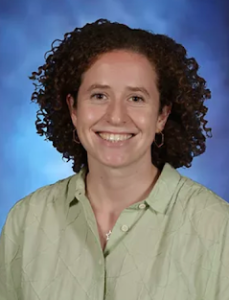
Anna Wohl
Gustavo Lopez, the son of immigrant parents, is a public secondary school social studies teacher in Los Angeles. He has taught 16 years both at the high school and middle school level. He is also the product of public education. He is passionate about curriculum, instruction, pedagogy, serving students and helping prepare a future generation of educators. In addition to loving the art and science that is teaching, he enjoys writing, theater, traveling and running.
Anna Wohl is a Jewish American educator from Los Angeles, CA. She got her Masters in Education from UCLA in 2020 and has spent the past five years teaching science at Luther Burbank Middle School in Highland Park, Los Angeles. She also coaches and trains students to run in the Los Angeles Marathon and co-leads the school’s GSA club. When she is not teaching, she enjoys backpacking, birdwatching, traveling, reading, and playing soccer.
Gustavo Lopez and Anna Wohl have been musing, exchanging ideas and collaborating on History and Science curriculum and pedagogy for the past two years. During this time, they have deepened their understanding of what it means to be not just department chairs but transformational instructional leaders. In the following blog post, they share their experience of finding connections and building relationships across two different departments at their school.
Interested in working with Lead by Learning to support professional learning for your Instructional Leadership Team? Connect with a member of our team to learn more about our partnerships.
